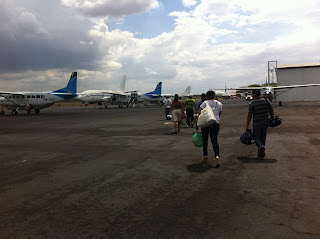I decided to move out of my host family's house when my coworker told me that the entire top floor of her house was empty because her family had decided to move to the bottom floor. I thought it would be nice to have some more space, be able to cook for myself, etc., and it was. However, only a couple days after I moved in there was a big storm and my coworker's house flooded. I had gone downstairs to see if the family had any extra buckets I could put under a couple of leaks in the upstairs roof and found them trying to sweep and mop out their flooded house. Needless to say, it was quite a bit worse than the couple of drips I had. There was like 2 or 3 inches throughout the whole house and the more we swept the more water accumulated. Somehow it filtered through the floor/wall from water that had pooled outside. Flooding is a problem in Puerto when it rains, and there are several neighborhoods that flood with several feet of water because they are low-lying and there is nowhere for the water to go. Most of the houses here are built on stilts for that reason. After a few hours of sweeping they gave up and decided to move back upstairs, and they moved everything...the couches, fridge, stove, beds. So now the house is definitely "cozy." It is nice to have some company though. They have two daughters, 3 and 7, who are pretty fun. The house is also home to a lot of pigeons and rats... The noises they make inside the walls are kind of creepy so I am glad to have people around at night.
The longer I am here in Puerto the more I like it. I've decided it is a really interesting place, and I wish I had some more time to get out and explore the region. The other day I met a gringo who is apparently the only licensed tour guide in the region and he was telling me about all the places I need to go. The fact that I work 6 days a week makes traveling hard, and things are really spread out over here. He said if I hadn't been out to the rural communities on the rivers, which is the "heart" of the Miskitu culture, that I hadn't seen anything. I would like to go, but I feel like not speaking Miskitu would kind of take away from the experience. He also seems to have some different ideas about tourism and what tourists want to see, like for example he told me the night before he had taken a group of American students to slaughter pigs. They do it in the middle of the night because there are less flies. As we were talking a giant truck showed up full of pigs, and he was like, "you gotta see this!" So I stayed for a few minutes to see them unload the pigs in the middle of the street in the market, and it was disturbing to say the least. I think I'll pass on that kind of tourism. I also don't like chicharron, which I guess is an integral part of the tour. The gringo also introduced me to a couple old-timer expats who were gathered around, I guess they stick together because I had never seen them before. There names were John Wayne and Old Bob or something like that, they seem like characters for sure.
Let's see...in other news, I started going to the gym with a coworker and another coworker's sister. I had tried an aerobics class a while back but was kind of disappointed by it. The gym is nothing amazing--I knew more or less what to expect because I had gone to the gym in El Salvador. However, it has been fun to go, and... they have a fridge full of coconuts inside the gym!!!! How amazing is that??? Pretty much the best thing ever. Do some cardio, go drink a fresh, cold coconut at the front desk, then go lift some weights... And they cost 7 cordobas, which is like 25 cents. I LOVE this gym.
I have some new photos but haven't uploaded them, but here are some very old ones from mother's day, which was the end of May, when I spent the day with the girls at the shelter. We made dulce de mango and painted nails. Mango season seems to go on forever here, and it is awesome--no worms in any of them!!
I haven't written much about the shelter, and I don't spend a lot of time there. I try to at least stop by to say hi to the girls every day though. It would be really hard to be there all the time as it is emotionally draining. I don't know how the women who work there do it. And if things weren't already hard enough, there is now a girl who got grisi siknis, which is an illness that only affects Miskitu adolescent girls. It is what is considered a "culture-bound syndrome." I had stumbled upon an article about it before I came. Apparently the girl has had a couple of attacks, only at night, but is now more stable. Wikipedia has some interesting info: http://en.wikipedia.org/wiki/Grisi_siknis
Today I spent the morning with the rest of the organization staff cleaning the shelter top to bottom, it was pretty dirty. This afternoon I am taking some of the girls to an art class at the museum, so I have to run, but I will post some more pictures soon!













